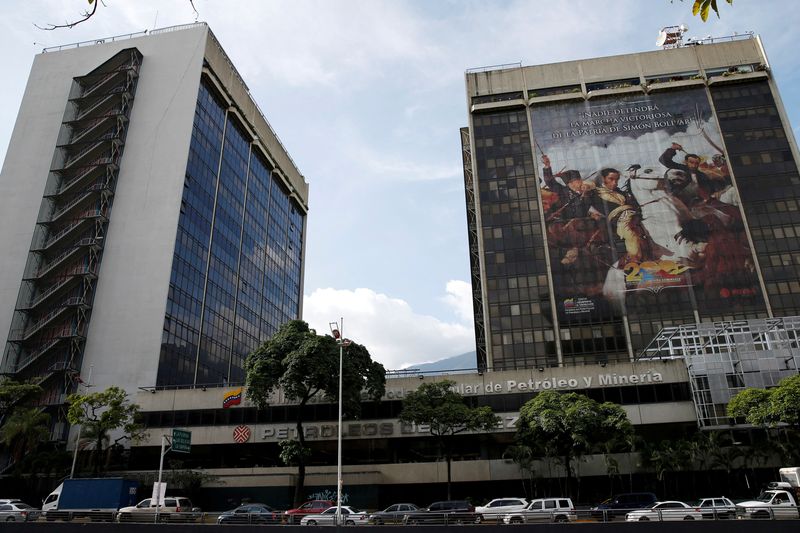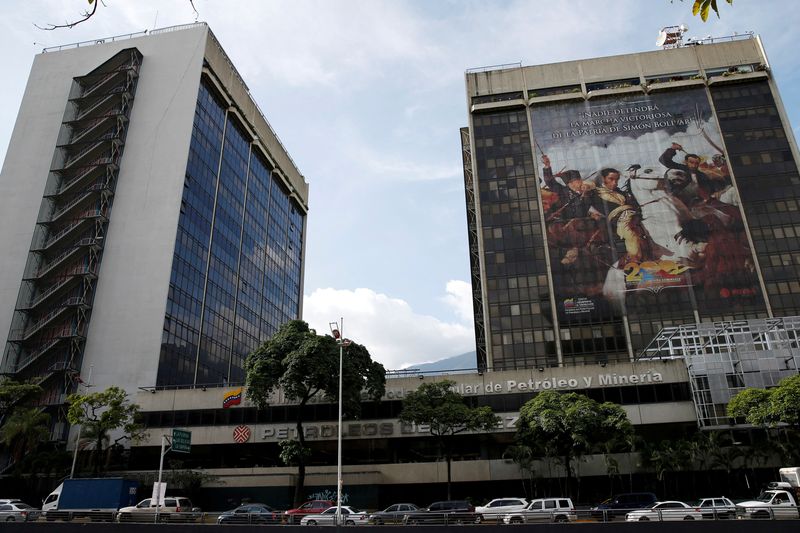Commodities
Return of US oil sanctions on Venezuela to hit revenue, fuel imports


© Reuters. FILE PHOTO: A general view of the headquarters of the Venezuelan oil company PDVSA in Caracas, Venezuela July 21, 2016. Picture taken July 21, 2016. REUTERS/Carlos Garcia Rawlins/File Photo
By Marianna Parraga and Mayela Armas
HOUSTON/CARACAS (Reuters) – A reimposition of U.S. sanctions on Venezuela’s oil and gas sectors would hurt the OPEC country’s ability to collect cash from its oil exports, crimp new energy investments and raise the risks of domestic fuel scarcity, analysts and executives said.
Washington this week ordered a wind down of all business transactions between U.S entities and Venezuela’s state miner Minerven, and said it would unwind in April its easing of energy sanctions if President Nicolas Maduro’s administration does not stick to an agreement signed last year to accept conditions for a fair presidential election.
The U.S. is increasing its pressure since the South American country’s top court last week upheld a ban blocking the leading opposition hopeful, Maria Corina Machado, from the election.
The U.S., which first imposed oil sanctions on Venezuela in 2019, had granted sanctions relief for the OPEC member country in October in recognition of the election deal.
As a result of easing sanctions, Venezuela was expected to grow its total oil revenue to as much as $20 billion this year from some $12 billion in 2023, according to Caracas-based consultancy Ecoanalitica. Larger exports of crude and petrochemicals to cash-paying customers in countries from the U.S. to India were behind its forecast.
“Price discounts on Venezuela’s crude had reduced a lot and cashing sales proceeds became easier for state company PDVSA. That was helping Maduro,” said Francisco Monaldi, director of the Latin American Energy Program at Rice University’s Baker Institute.
“If the license is withdrawn in April, the proceeds will be reduced again and the scenarios of strong economic growth and a competitive election will fade,” he added.
Risks of a new bout of acute fuel scarcity also are poised to increase, experts said.
Even if Washington continues authorizations for debt repayment deals to Chevron (NYSE:), Eni, Repsol (OTC:) and Maurel & Prom to avoid a total break with Venezuela, that might not provide sustainable investment to expand output.
“Specific licenses to one or two companies are not going to be very beneficial as a return of investment to Venezuela,” said Ali Moshiri, CEO of Amos Global Energy, which has interests in the South American country.
“That is not really going to move the needle for Venezuela’s oil sector to increase production significantly,” he added.
LOST EFFORT?
The U.S. sanction easing, which began in November 2022 with a special license to Chevron, marked a big change for the South American country’s coffers.
PDVSA since 2019 had been forced to switch most of its oil trading to swaps and funnel sales through intermediaries because customers did not want to be exposed to sanctions.
Oil exports by PDVSA and its joint venture partners rose almost 13% to an average 700,000 barrels per day (bpd) last year, tanker tracking data showed, while the country’s crude output grew 9% to 783,000 bpd. The company reestablished relationships with some of its former key clients.
The relaxation increased oil revenue, boosting Venezuela’s gross domestic product by 5% in 2023. It also paved the way for Venezuela to plan for an expansion of public spending for the first time in years to woo voters.
Venezuela’s oil minister Pedro Tellechea on Tuesday said the country was prepared to counter a return of sanctions and warned that the U.S. could also suffer from fewer Venezuelan oil exports.
But his message did little to calm companies that were planning purchases of Venezuelan oil and partnerships for energy projects in Venezuela, according to sources.
Commodities
Oil prices rise; U.S. crude inventories plunge, Russia-Ukraine truce eyed
Commodities
India’s Reliance to stop buying Venezuelan oil over US tariffs, sources say
Commodities
Oil prices climb on Venezuela supply worries

 Forex3 years ago
Forex3 years agoForex Today: the dollar is gaining strength amid gloomy sentiment at the start of the Fed’s week

 Forex3 years ago
Forex3 years agoUnbiased review of Pocket Option broker

 Forex3 years ago
Forex3 years agoDollar to pound sterling exchange rate today: Pound plummeted to its lowest since 1985

 Forex3 years ago
Forex3 years agoHow is the Australian dollar doing today?

 Cryptocurrency3 years ago
Cryptocurrency3 years agoWhat happened in the crypto market – current events today

 World3 years ago
World3 years agoWhy are modern video games an art form?

 Commodities3 years ago
Commodities3 years agoCopper continues to fall in price on expectations of lower demand in China

 Economy3 years ago
Economy3 years agoCrude oil tankers double in price due to EU anti-Russian sanctions



























